The Three Leaps of the Gazelle is an asterism formed by three pairs of stars in the constellation Ursa Major. The six stars mark the paws of the Great Bear. They shine at magnitudes 3.06 – 4.26 and can be spotted between the Big Dipper and the Sickle of Leo on a clear night.
The Three Leaps asterism has its origins in Arabic astronomy. In Arabic lore, the three pairs of stars represented the three leaps of a gazelle that dashed off across a large pond after being startled by the celestial Lion. The first leap is marked by the stars Alula Borealis (Nu Ursae Majoris) and Alula Australis (Xi Ursae Majoris), the second leap by Tania Borealis (Lambda Ursae Majoris) and Tania Australis (Mu Ursae Majoris), and the third leap by Talitha (Iota Ursae Majoris) and Alkaphrah (Kappa Ursae Majoris).
Talitha and Alkaphrah were historically known as Talitha Borealis and Talitha Australis, but when the International Astronomical Union (IAU) set out to standardize the proper names of stars in the 2010s, the other traditional name of Kappa UMa, Alkaphrah, was approved for the star. All six star names are derived from phrases that refer to the Three Leaps asterism.
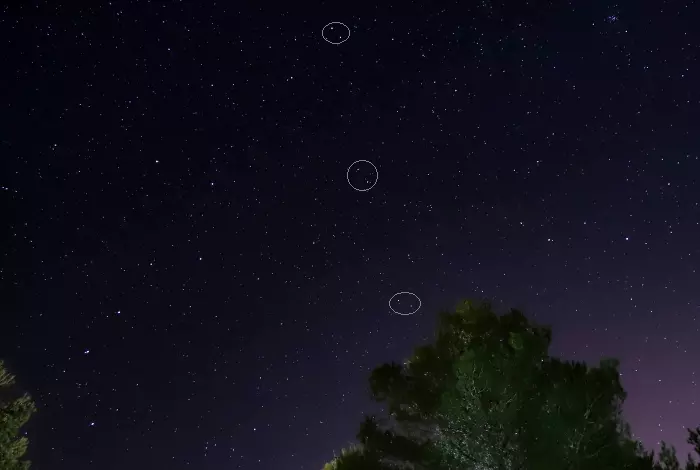
Three Leaps of the Gazelle, image: CG
The Three Leaps of the Gazelle corresponds to an ancient Chinese asterism called Three Steps. The Three Steps asterism was part of the larger Supreme Palace Enclosure, which represented the imperial court. Talitha and Alkaphrah represented the Upper Step (上台, Shàng Tái), Tania Borealis and Tania Australis the Middle Step (中台, Zhōng Tái), and Alula Borealis and Alula Australis the Lower Step (下台, Xià Tái).
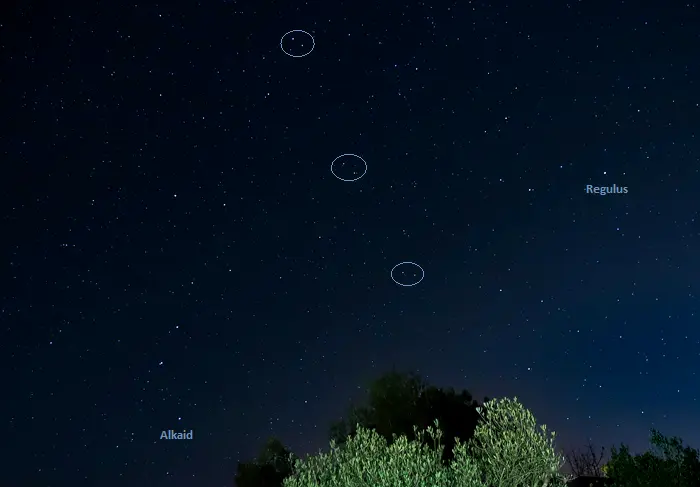
Three Leaps of the Gazelle, image: CG
Location
The Three Leaps of the Gazelle asterism lies in the region between the Big Dipper and the Sickle of Leo.
The stars of the first leap, Alula Borealis and Alula Australis, appear near the imaginary line connecting Alkaid, the star at the tip of the Big Dipper’s handle, and Regulus, the brightest star in Leo. They are closer to Regulus than to Alkaid.
The second leap, Tania Borealis and Tania Australis, is found halfway between Merak and Epsilon Leonis, the star at the tip of the Sickle of Leo.
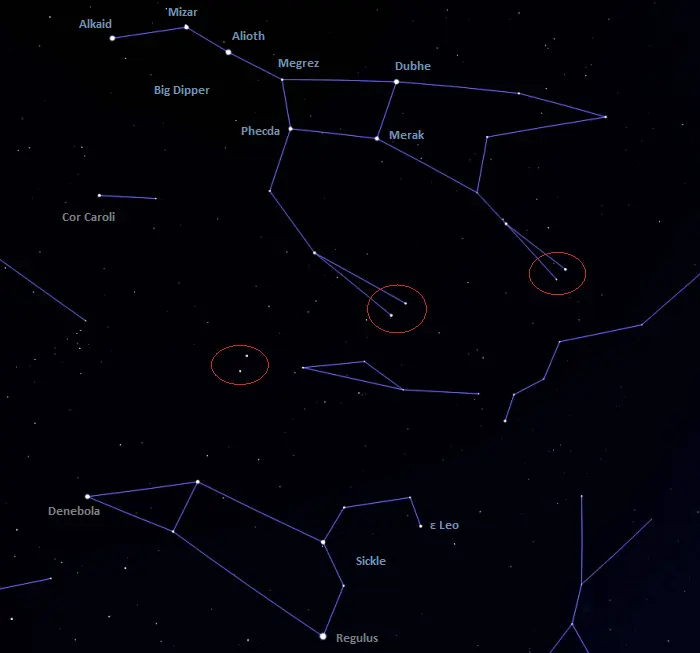
The location of Three Leaps of the Gazelle, image: Stellarium
Talitha and Alkaphrah, the stars of the third leap, appear along the imaginary line extended from Megrez through Merak.
The asterism can be used to find the faint constellations Leo Minor and Lynx. The stars of the first and second leaps lie next to the border with Leo Minor, while the third leap appears near the border with Lynx. Praecipua, the brightest star in Leo Minor, is the brightest star between the first and second leaps.
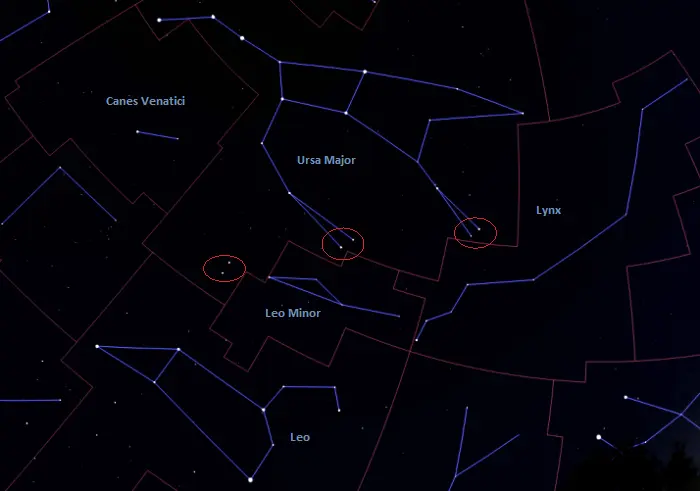
Three Leaps of the Gazelle, Leo Minor and Lynx, image: Stellarium
Stars
The six stars that form the Three Leaps of the Gazelle get their names from their position in the asterism.
Alula Borealis and Alula Australis represent the first leap of the gazelle. The name Alula comes from the Arabic phrase Al Ḳafzah al Ūla, meaning “the first leap” or “the first spring.” The words borealis and australis mean “northern” and “southern” in Latin respectively.
Tania Borealis and Tania Australis mark the second leap. The name Tania comes from Al Fiḳrah al Thānia, meaning “the second leap (spring).”
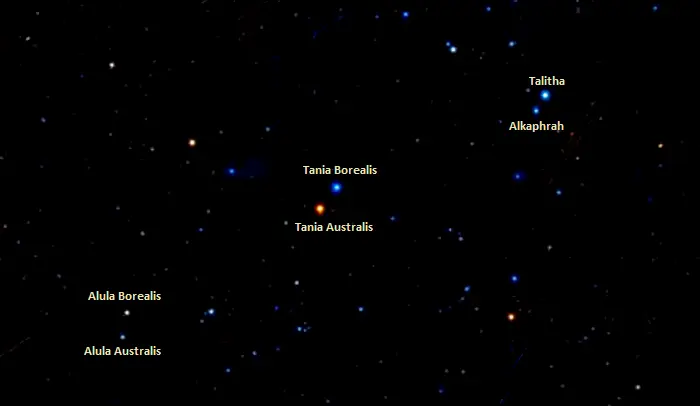
The six stars that form the Three Leaps of the Gazelle, image: Wikisky
Talitha and Alkaphrah mark the third leap. The name Talitha is derived from the Arabic Al Fiḳrah al Thalitha, “the third leap (of the gazelle).” Alkaphrah is a corrupted form of the traditional name Alkafzah, derived from the Arabic al-qafzah, meaning “the leap.”
Tania Australis (Mu UMa) is the brightest of the six stars. It shines at magnitude 3.06 from a distance of 183 light-years. The faintest, Alula Australis (Xi UMa), has an apparent magnitude of 4.264 and lies 29 light-years away.
Alula Borealis and Alula Australis
Alula Borealis (Nu Ursae Majoris) is a double star located approximately 399 light-years away. The primary component is an orange giant of the spectral type K3 III. The star has a radius 57.07 times that of the Sun and is about 775 times more luminous than our star. The companion is a 10th-magnitude star at an angular separation of 7.1 arcseconds.
Alula Australis (Xi Ursae Majoris) is the primary component in a multiple-star system composed of two pairs of single-lined spectroscopic binary stars and two other components. The star system lies 29 light-years away and has an apparent magnitude of 4.41.
The two main components, Xi UMa A and Xi UMa B, are separated by 2.3 arcseconds and orbit each other with a period of 59.84 years. The two components of Xi UMa A have an orbital period of 669 days, while the components of Xi UMa B complete an orbit every 3.98 days.
The four stars have masses of 0.97 (Xi UMa Aa), 0.38 (Xi UMa Ab), 0.86 (Xi UMa Ba), and 0.14 (Xi UMa Bb) solar masses. The brighter pair has the spectrum of a main sequence star of the spectral type F8.5: V, and the companion pair has the stellar classification G2 V, indicating a yellow dwarf.
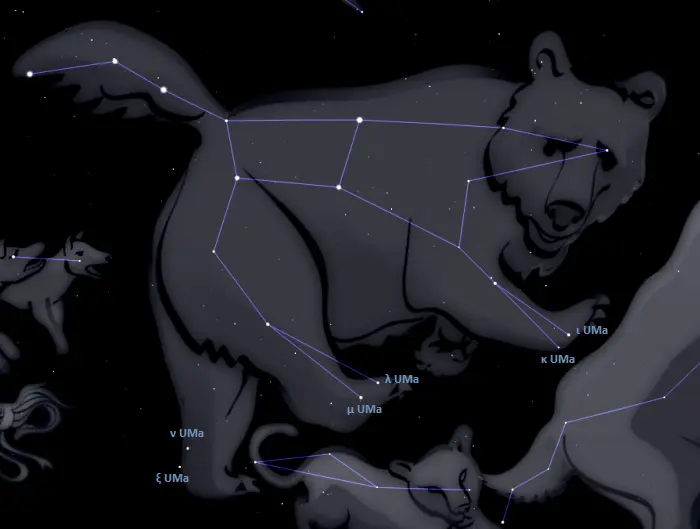
The paws of the Great Bear, image: Stellarium
Tania Borealis and Tania Australis
Tania Borealis (Lambda Ursae Majoris) is a subgiant star of the spectral type A2 IV. It has a visual magnitude of 3.45 and lies 138 light-years away. The star has a mass of 2.11 solar masses and a radius 2.3 times that of the Sun. With an effective temperature of 9,247 K, it is 37 times more luminous than the Sun. It has an estimated age of 380 million years.
Tania Australis (Mu Ursae Majoris) is a binary star located 183 light-years away. It shines at magnitude 3.06 and is the eighth brightest star in Ursa Major. The primary component is a red giant on the asymptotic giant branch (AGB). It has the stellar classification M0 III ab. The star has a radius 75 times that of the Sun and is between 977 and 1,200 times more luminous than our star. The companion lies at a physical separation of only 0.2 astronomical units (Earth–Sun distances). The two components have an orbital period of 230 days.
Talitha and Alkaphrah
Talitha (Iota Ursae Majoris) is the primary component in a multiple-star system located 47.3 light-years away. It has an apparent magnitude of 3.14. The star was nicknamed Dnoces (the word “second” backwards) by Apollo I astronaut Gus Grissom, after his colleague Edward H. White II. However, this name is not in common use.
The Iota Ursae Majoris system consists of two pairs of binary stars. The binary pairs orbit each other with a period of 2,084 years.
The primary component in the system is an A-type subgiant locked in a 4,028-day orbit with a white dwarf companion. The star has a mass of 1.7 solar masses and is 9.87 times more luminous than the Sun. It has an estimated age of 620 million years.
The second pair is composed of 9th-magnitude and 10th-magnitude red dwarfs with an orbital period of 39.7 years. The stars have masses of 0.35 and 0.30 solar masses.
Alkaphrah (Kappa Ursae Majoris) is the primary component in a binary star system located 360 light-years away. The system consists of two A-type main sequence stars. The two components have an orbital period of 13,007.2 days.
The primary component has a mass of 3.79 solar masses and a radius 7.87 times that of the Sun. It is an exceptionally fast spinner, with a projected rotational velocity of 201 km/s.
The star system shines at a combined magnitude of 3.56. The individual stars have apparent magnitudes of 4.16 and 4.54.